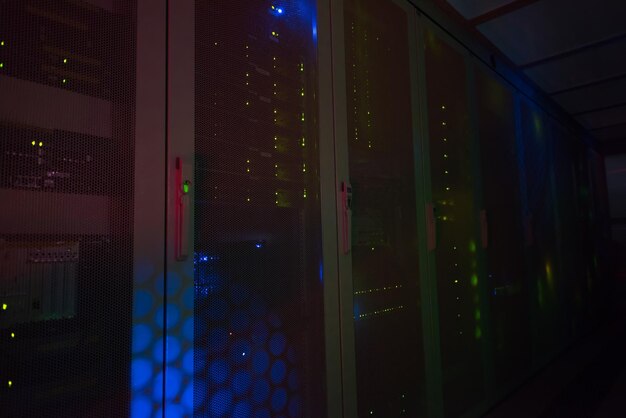AI Cybersecurity for US Infrastructure: Challenges & Opportunities

Developing AI-powered cybersecurity solutions for US infrastructure presents both significant challenges, including data bias and workforce limitations, and considerable opportunities, such as enhanced threat detection and automated response capabilities.
Securing US infrastructure with AI-powered cybersecurity solutions presents a complex landscape of hurdles and possibilities. Understanding these nuances is crucial for effective deployment and defense against evolving cyber threats, and this article dives into those nuances.
Understanding the AI Cybersecurity Landscape for US Infrastructure
The integration of artificial intelligence (AI) into cybersecurity for US infrastructure is rapidly transforming how we protect critical assets. From power grids and water systems to transportation networks, AI offers new capabilities to detect, prevent, and respond to cyber threats that were previously unimaginable. However, this technological advancement also introduces new challenges and complexities that must be addressed for effective and reliable deployment.
This section explores the current state of AI cybersecurity in US infrastructure, highlighting the key applications and benefits, as well as the inherent risks. We will delve into why AI is becoming essential for modern cybersecurity strategies and how it is reshaping the defense landscape.
The Role of AI in Modern Cybersecurity
AI’s ability to process vast amounts of data quickly and accurately makes it invaluable in modern cybersecurity. Traditional security systems often struggle to keep up with the volume and sophistication of cyberattacks, but AI can analyze patterns, detect anomalies, and predict potential threats in real-time.
By automating routine tasks, AI frees up human analysts to focus on more complex and strategic issues, improving overall efficiency and response times. This proactive approach enables organizations to stay one step ahead of cybercriminals, mitigating potential damage before it occurs.
- Enhanced Threat Detection: AI algorithms can identify subtle indicators of compromise that might be missed by traditional security tools.
- Automated Incident Response: AI can automatically respond to threats, such as isolating infected systems or blocking malicious traffic.
- Predictive Security: AI can analyze historical data to predict future attacks and proactively strengthen defenses.
Incorporating AI into cybersecurity is not without its hurdles. Ensuring data privacy, addressing algorithmic bias, and maintaining transparency are critical considerations. However, with careful planning and ethical implementation, AI can significantly enhance the security posture of US infrastructure.
Key Challenges in Implementing AI Cybersecurity
Implementing AI-powered cybersecurity solutions in US infrastructure is not a straightforward task. Several key challenges must be addressed to ensure that these solutions are effective, reliable, and secure. These challenges range from technical issues to ethical and regulatory considerations.
This section will detail some of the most significant hurdles in deploying AI cybersecurity, including data availability and quality, algorithmic bias, and the need for skilled professionals. Understanding these challenges is crucial for developing strategies to overcome them and maximize the benefits of AI in securing critical infrastructure.

Data Availability and Quality
AI algorithms require large amounts of high-quality data to learn and perform effectively. However, obtaining sufficient and relevant data can be a significant challenge for many US infrastructure organizations. The data may be fragmented, incomplete, or inconsistent, making it difficult to train robust and reliable AI models.
Additionally, sensitive data must be handled carefully to comply with privacy regulations and protect against unauthorized access. Ensuring data security and compliance while leveraging it for AI training requires a multifaceted approach.
Algorithmic Bias
AI algorithms are only as good as the data they are trained on. If the training data is biased, the resulting AI model will also be biased, leading to unfair or inaccurate outcomes. In cybersecurity, algorithmic bias can result in certain types of attacks being overlooked or disproportionately targeting certain user groups.
Addressing algorithmic bias requires careful attention to data collection, preprocessing, and model evaluation. It also necessitates ongoing monitoring and refinement to ensure that the AI system remains fair and accurate over time.
- Diverse Datasets: Use diverse datasets that accurately represent the range of potential threats and system behaviors.
- Bias Detection Tools: Employ tools to detect and mitigate bias in both data and algorithms.
- Regular Audits: Conduct regular audits to assess the fairness and accuracy of AI-powered cybersecurity systems.
Despite these challenges, the potential of AI to revolutionize cybersecurity is undeniable. By addressing data quality issues and mitigating algorithmic bias, organizations can unlock the full potential of AI to protect US infrastructure.
Opportunities for AI-Powered Cybersecurity Solutions
Despite the challenges, the opportunities for leveraging AI in cybersecurity for US infrastructure are vast and promising. By automating routine tasks, enhancing threat detection, and improving incident response, AI has the potential to transform the way we protect critical assets.
This section will focus on the potential benefits of AI in cybersecurity, including enhanced threat detection and prevention, automated response and remediation, and improved security analytics and intelligence. These opportunities can lead to a more resilient and secure infrastructure, better equipped to withstand evolving cyber threats.
Enhanced Threat Detection and Prevention
One of the most significant opportunities for AI in cybersecurity is its ability to enhance threat detection and prevention. AI algorithms can analyze vast amounts of data from various sources to identify subtle indicators of compromise that might be missed by traditional security tools.
By continuously learning from new data and evolving threat patterns, AI can proactively identify and neutralize potential threats before they cause damage. This proactive approach can significantly reduce the risk of successful cyberattacks and minimize the impact of breaches.

Automated Response and Remediation
AI can also automate incident response and remediation, enabling organizations to respond to threats more quickly and effectively. AI-powered systems can automatically isolate infected systems, block malicious traffic, and initiate recovery procedures without human intervention.
This automation not only reduces response times but also frees up human analysts to focus on more complex and strategic issues. By automating routine tasks, AI improves overall efficiency and reduces the risk of human error during critical incidents.
- Rapid Incident Response: AI can automatically detect and respond to incidents in real-time, minimizing the impact of attacks.
- Automated Recovery: AI can initiate automated recovery procedures to restore systems to a secure state.
- Adaptive Security: AI can continuously adapt security measures based on evolving threat patterns and system behaviors.
Leveraging AI for automated response and remediation requires careful planning and testing to ensure that the systems are reliable and effective. However, the potential benefits in terms of improved security and reduced response times are substantial.
Regulatory and Compliance Considerations
Implementing AI cybersecurity solutions in US infrastructure must take into account various regulatory and compliance considerations. These regulations aim to protect sensitive data, ensure fairness and transparency, and mitigate potential risks associated with AI technologies.
This section discusses some of the most relevant regulatory frameworks and compliance standards that organizations must adhere to when deploying AI cybersecurity solutions. These include data privacy regulations, industry-specific cybersecurity standards, and ethical guidelines for AI development and deployment.
Data Privacy Regulations
Data privacy regulations, such as the California Consumer Privacy Act (CCPA) and the General Data Protection Regulation (GDPR), impose strict requirements on how organizations collect, use, and protect personal data. AI cybersecurity solutions that process personal data must comply with these regulations to avoid penalties and maintain public trust.
Compliance with data privacy regulations requires implementing appropriate security measures, obtaining consent for data processing, and providing individuals with the right to access, correct, and delete their data. Organizations must also be transparent about how they use AI and ensure that their systems are fair and non-discriminatory.
Industry-Specific Cybersecurity Standards
Certain industries, such as finance and healthcare, are subject to specific cybersecurity standards and regulations that require organizations to implement robust security controls to protect sensitive information. These standards often include specific requirements for the use of AI in cybersecurity.
Compliance with industry-specific standards requires a thorough understanding of the applicable regulations and the implementation of appropriate security measures. Organizations must also conduct regular audits and assessments to ensure that their AI cybersecurity solutions meet the required standards.
Balancing regulatory compliance with AI innovation requires a proactive and transparent approach. By integrating compliance considerations into the AI development lifecycle, organizations can ensure that their cybersecurity solutions are both effective and ethical.
The Future of AI in Cybersecurity for US Infrastructure
The future of AI in cybersecurity for US infrastructure is poised for significant growth and innovation. As AI technologies continue to evolve and mature, they will play an increasingly critical role in protecting critical assets from cyber threats. This section explores some of the key trends and developments that are shaping the future of AI cybersecurity.
From advanced threat intelligence and proactive security measures to increased automation and collaboration, the future of AI cybersecurity promises to be more resilient, adaptive, and effective. However, realizing this potential requires addressing the challenges and embracing the opportunities that lie ahead.
Advanced Threat Intelligence
AI is expected to play an increasingly important role in gathering and analyzing threat intelligence. AI-powered systems can automatically scan the internet, dark web, and other sources to identify emerging threats, track threat actors, and predict potential attacks.
This advanced threat intelligence can be used to proactively strengthen defenses, improve incident response, and inform strategic decision-making. By leveraging AI to stay one step ahead of cybercriminals, organizations can significantly reduce the risk of successful cyberattacks.
Proactive Security Measures
The future of AI cybersecurity will also focus on proactive security measures that anticipate and prevent attacks before they occur. AI-powered systems can continuously monitor systems for vulnerabilities, identify suspicious activity, and automatically implement security controls to mitigate potential risks.
This proactive approach not only reduces the risk of successful cyberattacks but also improves overall security posture and resilience. By leveraging AI to proactively identify and address vulnerabilities, organizations can minimize the impact of breaches and maintain a secure environment.
- AI-Driven Vulnerability Management: Automatically scan for and remediate vulnerabilities.
- Behavioral Analytics: Detect and respond to anomalous behavior that may indicate a cyberattack.
- Adaptive Security Architecture: Continuously adapt security measures based on evolving threat patterns.
The future of AI in cybersecurity is bright, but it requires a commitment to innovation, collaboration, and ethical development. By embracing these principles, organizations can unlock the full potential of AI to protect US infrastructure from evolving cyber threats.
Building a Skilled Workforce for AI Cybersecurity
One of the most critical factors for successfully implementing AI cybersecurity solutions in US infrastructure is having a skilled workforce. However, the demand for AI and cybersecurity professionals far exceeds the current supply, creating a significant skills gap. This section explores the challenges of building a skilled workforce and the strategies for addressing them.
From education and training programs to industry partnerships and workforce development initiatives, this section will provide actionable insights for building a skilled workforce that can drive the adoption and innovation of AI cybersecurity solutions. By investing in workforce development, organizations can ensure that they have the talent needed to protect critical infrastructure from cyber threats.
Education and Training Programs
Education and training programs play a critical role in building a skilled workforce for AI cybersecurity. These programs should provide students and professionals with the knowledge and skills needed to develop, deploy, and manage AI-powered security solutions.
Education and training programs on the following are important:
- AI and Machine Learning Fundamentals
- Cybersecurity Principles and Practices
- Data Science and Analytics
“`html
| Key Point | Brief Description |
|---|---|
| 🛡️ Threat Detection | AI enhances threat detection by quickly analyzing vast amounts of data. |
| 🤖 Automation | AI automates incident response, freeing up human analysts. |
| 📊 Data Bias | Addressing data bias ensures fair and accurate AI outcomes. |
| 🧠 Workforce | Building a skilled workforce is crucial for AI cybersecurity success. |
“`
Frequently Asked Questions
▼
AI is used for threat detection, automated incident response, vulnerability management, and predictive security. It enhances the ability to identify and neutralize cyber threats.
▼
Challenges include data availability and quality, algorithmic bias, regulatory compliance, and the need for a skilled workforce to manage and develop these systems.
▼
Organizations can ensure data privacy by implementing strong security measures, obtaining consent for data processing, and adhering to data privacy regulations such as GDPR and CCPA.
▼
Ethical considerations include ensuring fairness, transparency, and accountability in AI systems. It’s important to address algorithmic bias and protect against unintended consequences.
▼
The skills gap can be addressed through education and training programs, industry partnerships, and workforce development initiatives. These efforts should equip professionals with AI and cybersecurity skills.
Conclusion
Developing AI-powered cybersecurity solutions for US infrastructure presents numerous challenges and opportunities. By addressing data bias, regulatory requirements, and workforce limitations, while leveraging the benefits of enhanced threat detection and automated response, organizations can build more resilient and secure systems to protect critical assets from evolving cyber threats.





